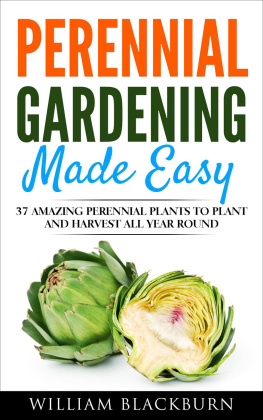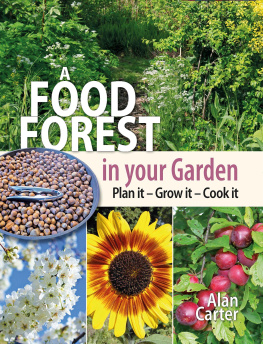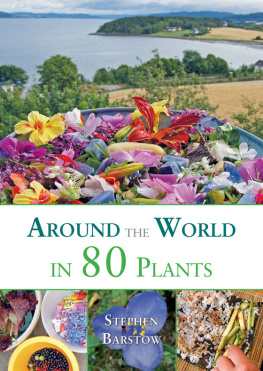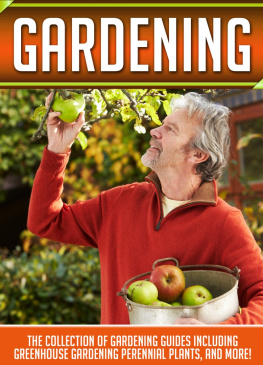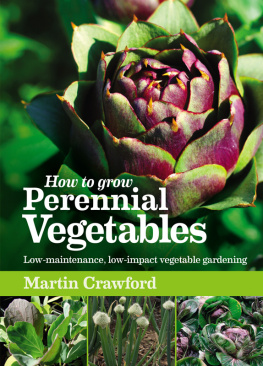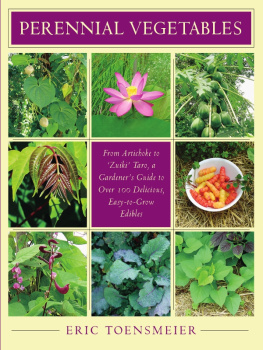EDIBLE PERENNIAL GARDENING
Growing Successful Polycultures in Small Spaces
ANNI KELSEY
PERMANENT PUBLICATIONS
Published by Permanent Publications
Hyden House Ltd
The Sustainability Centre East Meon
Hampshire GU32 1HR
United Kingdom
Tel: 0844 846 846 4824 (local rate UK only) or +44 (0)1730 823 311
Fax: 01730 823 322
Email:
Web: www.permanentpublications.co.uk
Chelsea Green Publishing Company, PO Box 428, White River Junction, VT 05001
www.chelseagreen.com
2014 Anni Kelsey
The right of Anni Kelsey to be identified as the author of this work has been asserted by her in accordance with the Copyrights, Designs and Patents Act 1998
Anni Kelseys blog: http://annisveggies.wordpress.com
Photographs Anni Kelsey, unless stated otherwise Illustrations by Emma Lawrence, www.emmalawrence.com
Designed by Two Plus George Limited, wwwTwoPlusGeorge.co.uk
Index by Amit Prasad,
eBook conversion eBookPartnership, ebookpartnership.com British Library Cataloguing-in-Publication Data A catalogue record for this book is available from the British Library PRINT: ISBN 9781856231497
PDF: ISBN 9781856231503
EPUB: ISBN 9781856231510
MOBI: ISBN 9781856231527
All rights reserved. No part of this publication may be reproduced, stored in a retrieval system, rebound or transmitted in any form or by any means, electronic, mechanical, photocopying, recording or otherwise, without the prior permission of Hyden House Limited.
CONTENTS
The Author
Anni Kelsey has been aware of environmental issues since finding a Greenpeace leaflet at school in 1972. She studied Geography and graduated from Aberystwyth University with a first class degree in 1990. This led to research and project management work in economic and community development and urban regeneration schemes. Looking for something more meaningful and life affirming she then trained in reflexology, Bowen technique, and nutritional medicine and says, I have learned how to keep myself and my family very healthy! Her passion lies with forest gardening, permaculture and The Transition Movement. Anni currently works as an administrator, has two grown up children, and spends her spare time outside in the garden or countryside, reading, researching and writing.
This book is dedicated to its readers
Acknowledgements
Many people have contributed to this book without being aware that they have done so. They are the writers and bloggers that I have been avidly reading. To undertake research and complete this project I have needed much more than mere technical details of rare and unusual plants and seeds, where to buy them and how to grow them; I have needed inspiration. In particular I have found it in the blogs of people who are looking into the future and working out in very practical ways how they can make their bit of difference. Whether by living closer to nature, growing their own food, helping their communities in Transition, living by the principles of permaculture I have found masses of inspiration which has been invaluable to helping me focus on the task of working out how to grow an edible perennial garden in the context of a changing world.
A massive thank you must go to the team at Permanent Publications and in particular to Maddy and Tim Harland who live by the ethics of the permaculture message that they have done so much to spread. I am indebted to Maddys recognition of the potential for a book about perennial vegetables and her continuing enthusiasm and support throughout, and particularly thank Tim for his meticulous approach and eye for detail.
I am indebted to Emma Lawrence who has produced the drawings contained in this book. Starting from my basic and scrappy sketches she has done her own research into the topics illustrated and with immense care and thoughtfulness turned them into lovely pictures that show exactly what I had hoped for.
It has also been good to have the support of friends and family who have taken such an interest over the past few years.
Most importantly there is my beloved partner Pat, who makes all the difference to everything. She has given me never ending support and encouragement. In the early days (when it was not at all clear that the project would be as successful as it has been) it must have been a trial to see her once respectable garden turned over to riotous polycultures which included dandelions and nettles. However she has just reminded me that it was her idea to extend the area under cultivation to give more space for my experiments! She has also helped to find imaginative ways to cook and eat the unusual foods that now grace our table.
FOREWORD
L earning to produce food from perennials is a matter of critical importance for the 21st century. Perennials sequester carbon and help slow climate change, and can prevent erosion, slow and infiltrate rainfall, and reduce labor and inputs. Growing those perennial crops in polycultures adds even more benefits, and can give birth to productive novel ecosystems in our farms and gardens.
For those of us in cold climates, however, there is much to learn before these systems are ready for scaling up. Few nurseries and seed companies stock perennial crops (Kelsey lists many such sources). Learning to grow and build polycultures around perennial food plants can be difficult. Perhaps the hardest thing is learning to incorporate these crops in our diets on a daily basis.
What our movement needs now is to hear the stories of the innovative growers who are learning what perennial crops grow well for them, how they are managing them, and how they are combining them in polycultures. Anni Kelseys Edible Perennial Gardening: Growing Successful Polycultures is filling this important need.
Kelsey has almost a decade of experience growing perennial vegetables in polycultures. She reports on her experiences what grows easily, what is killed by frost, what the slugs and cabbage moths go after. Permaculture is sometimes accused of oversimplifying and making it all sound too easy. Here Kelsey provides the antidote, sharing mistakes and failures in the context of her overall success in growing a diverse blend of long-lived vegetable crops and companion species.
Particularly of value are her thoughts on managing for balance in polycultures, and the importance of monitoring and guiding succession in the edible perennial garden. These observations come from real personal experience and are invaluable to all of us in this movement.
Even better, Kelsey has tracked labor by month and yields. To my knowledge this is the very first time anyone in the movement has been able to say how many kilograms of perennial food she produced with so many hours of labor. Im most grateful to her for this contribution to our movement and hope she will inspire others to do the same.
Eric Toensmeier
Author of Paradise Lot and Perennial Vegetables, co-author of Edible Forest Gardens
Holyoke, Massachusetts, USA
October 2013

INTRODUCTION
Anticipation
Looking towards a sustainable future when a polyculture of perennial vegetables is as familiar a feature of our gardening landscape as the conventional vegetable patch.
I have always loved gardening. It is one of my very favourite things. However I used to feel that at best I was only just keeping on top of things, the garden always had more energy to put into growing than I did to put into its control, and it never took a day off. So it was in the summer of 2005 as I once again hacked back the excessive growth in the shrub borders that the thought struck me how good would it be if this exuberant greenery was all edible? Clearly the garden was capable of producing vast quantities of greenery, would it not be wonderful if I could eat it? What a lot of work it would save!


